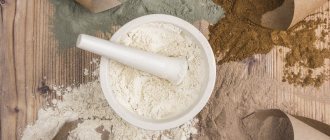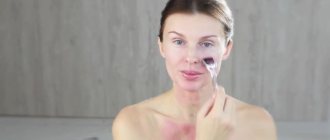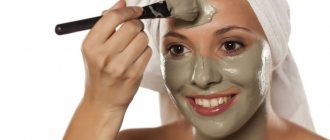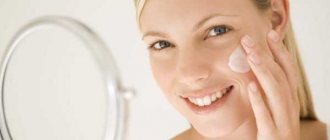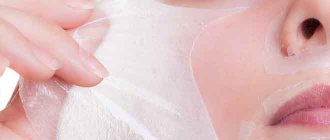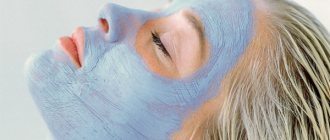All women love to take care of themselves. The question is, are they doing everything right? Did you know that after a clay mask, you must apply face cream, even if you used a moisturizing mask? The fact is that any type of mask, if it contains clay, removes the top layer of skin. And with regular use, the protective functions weaken, and the skin becomes vulnerable to cold and other external factors. This does not mean that you cannot use clay, no - it is even necessary, but within reasonable limits and in the correct dosage.
What you will learn:
- Why do you need cream after a clay mask Skin types and face cream
- Skin type 1 – Dry
- Skin type 2 – Normal
- Skin type 3 – Oily
- Skin type 4 – Combination
Clay, due to its healing properties[1], has been widely used in skin care for a long time.
As studies show[2], the use of certain types of clay helps eliminate excess sebum, cleanse and refresh the skin, and also promotes the healing of pimples[3]. However, there are still several myths surrounding clay masks. We'll look at three of the most common mistakes and give tips on how to get the most out of your mask.
Types of cosmetic clay
Before we tell you how to make a clay face mask, let's talk about what this cosmetic product is.
- White clay (kaolin)
It is a rock containing the mineral kaolinite, which is the basis for its name. The important ability of kaolin to whiten the skin has made white clay a popular product in cosmetology. Masks based on it brighten the complexion, reducing pigmentation and the severity of freckles. Clay tightens pores well, creating a slight lifting effect. It is considered an excellent absorbent and natural antiseptic for wounds.
- Blue clay (keel)
In our country, this breed has long been mined in Crimea, and abroad – in Bulgaria. The more well-known name for the mineral is “soapstone.” Due to the presence of silver in the composition, it has a blue-green color with a hint of blue or yellow, as well as powerful antiseptic properties. For the same reason, masks based on clubroot are indicated for acne. They perfectly increase cellular metabolism and rejuvenate the skin.
- Green clay (illite)
Has a beneficial effect on mature facial skin, increasing its firmness and elasticity. Smoothes out networks of wrinkles. The zinc contained in its composition acts as an antiseptic and reduces inflammation. This mask eliminates oily shine and has matting properties.
Recommended reading:
- What not to do after eyelash extensions
- Which eyelash extension to choose for yourself
- Eyelash care: advice from professionals
- Yellow clay
The optimal product for aging, problematic and tired skin. Due to the high content of potassium and iron, the mask removes waste and toxins well. Stimulates blood circulation, improving the respiration of epithelial cells. Has tonic properties.
- Red (pelagic) clay
It is mined in the oceans at a depth of 4-5 km, rich in microelements (copper, manganese, iron), useful for capillaries. Perfectly saturates the epidermis with oxygen. Recommended for skin prone to irritation.
Work done in our studio “Anna Klyuchko”. Sign up for eyelash extensions
- Pink clay
A unique cosmetic product for any skin type with the qualities of red and white clay. This is an economical option for salon peelings or artificial mineralization. Suitable for sensitive and thin skin.
- Black clay
An excellent cleanser with iron, calcium and quartz in its composition. Improves blood flow and accelerates cellular metabolism. Helps remove toxins, oil and dirt. Promotes regeneration. With regular use, it returns a clear oval face.
Next, we’ll look at how to make clay face masks at home.
Mistake 1: Choosing a mask without taking into account your skin type
Clay is the basic term for different types of mineral compounds, and each type of clay has different properties. This means that there is a specific type of clay for a specific skin type and specific needs. White clay is a gentle micro-granular cleanser that removes excess sebum without drying out the skin (so great for sensitive and dry skin). Green clay has more powerful adsorption and absorption properties, making it more suitable for oily skin. Charcoal—actually pure carbon rather than clay—is known for its ability to cleanse the skin of impurities and toxins.[4]
How clay face masks help different skin types
- This component in the mask works as an absorbent. Clay pulls out all harmful substances from the epidermis - absorbs pollution, excess sebum and heavy metals. This is how detox and deep cleansing occurs. After this, the skin will be better able to accept the beneficial components of subsequent care - toner, serum or cream.
- Clay masks not only get rid of harmful substances and add beneficial ones. Korean brands add valuable components to their formulations that care for the skin and help the clay not dry out the skin so much.
- Clay normalizes the functioning of the sebaceous glands, stimulates regeneration and renewal of the skin. Tightens pores, dries and soothes inflammation.
- Clay-based masks lighten pigmentation and acne, even out tone, making the skin healthy, clean and beautiful.
Very often the question arises: why buy Korean clay face masks if you can dilute the finished product with water. The problem is that using regular clay can lead to irritation and drying - without caring components it will be too aggressive on the skin. Therefore, specialists from different brands in laboratories create unique product formulas that are truly effective and gentle on the skin. In addition, in addition to clay, masks also contain many other valuable components - for example, extracts of green tea, centella, wormwood, strawberry, and red wine.
A purifying foaming clay bubble face mask. 100 ml, 1,120 RUR
This beauty procedure is suitable for all skin types. Those with combination and oily skin will definitely like clay-based masks - they just need regular cleansing. But if you choose a clay mask for dry skin, carefully study the composition and look for pink clay and moisturizing components in it so as not to dry out the epidermis. Clay absorbs excess sebum, which dry types already lack.
Mistake 2: Keeping the clay mask on for more than 10 minutes
Clay face masks penetrate the skin, absorbing excess sebum (absorption) and drawing out and binding impurities (adsorption). This means that if you leave the mask on for too long, the clay can dry out your skin. Instead of waiting for the mask to dry completely on your face, leave it on for no more than 10 minutes, as recommended for use with the Pureté Thermale Pore Purifying Clay Mask. If your skin feels dry or tight after removing the mask, use Mineral 89 soothing mineralized water to instantly restore moisture balance.
How to use a clay mask
To understand how long to keep a clay mask on your face, focus on your skin type.
If you have combination or oily skin, use the mask once a week, apply for 10-15 minutes. If the skin is dry or sensitive - no more than twice a month, for only 5-7 minutes. At the same time, make sure that the mask does not dry out completely on your face - moisturize it with a mist.
- Remove makeup with micellar water or hydrophilic products. Then cleanse your skin with your favorite foam or gel wash. If possible, you can steam your face before applying the mask to open the pores.
- Avoiding the area around the eyes (the skin of the eyelids is too thin and sensitive) and lips, apply the product in a thick, opaque layer. Many people do not know how best to apply a clay mask to their face. It is much more convenient to do this with a special brush - this way you get a perfect even layer
- After the specified time, rinse off the mask with warm water.
- Apply moisturizer to seal the effect and not dry out the skin.
Multimasking with pink and black clay for combination skin. 160 ₽
After what types of masks should the cream be applied?
All cleansing, moisturizing, lifting effects, anti-aging, soothing and nourishing masks are divided into professional ones, which are used by cosmetologists, and home ones.
After the salon procedures, the master will tell you in detail whether it is necessary to specifically apply cream, lotion after the intensive procedure or not. When self-care, in order to be sure that the session is completed correctly, you should understand the types of masks:
- Creamy - maintain lipid balance, soften, nourish and moisturize. Suitable for sensitive, thin and dry, aging skin. Especially recommended during the cold season. After them, you don’t have to apply cream; besides, many of the cream masks do not require rinsing after application and are used at night. It is good to apply serums, hyaluronic acid and vitamin cocktails from ampoules under them. After removing the mask, you cannot immediately go out into the cold.
- Gel (including film) - relieve irritation, constrict blood vessels, which eliminates redness, help reduce pigmentation after the sun, tone, smooth out wrinkles. Before applying them, it is also recommended to add rich products and even cream. Thanks to its light structure, it is ideal for use in summer. Easily absorbed without overloading problematic and oily skin. After the gel mask, wipe the face with tonic or an ice cube, and apply a suitable cream or milk. Oily skin will also benefit from a moisturizing mist.
- Fabric masks have a variety of effects, are very convenient to use and are simply a godsend for busy women. Provide superficial hydration, nutrition, whitening, relieve inflammation, reduce sagging, eliminate skin imperfections. After removal, it is recommended to rub the residue into the skin with light self-massage movements. Do I need to wash my face after using a sheet mask? No, because the components continue to have a beneficial effect on the skin. Additionally, there is no need to use cream, because for instant action the product contains a large amount of active substances that prepare the skin for the application of decorative cosmetics or replace night cream. But if you continue basic care, it won’t get worse.
- Powdered - alginant (plasticizing) and kaolin (modeling). They require dilution to a paste-like state (sometimes sold ready-to-use). Depending on the biological additives, such additional targeted care products help increase the barrier functions of the epidermis, reduce swelling, cleanse, tighten, nourish, and smooth the skin. After modeling compositions, cream is necessary. And under alginant ones, serum or saturated emulsions and compositions are sometimes applied, which are quite sufficient. It is not forbidden to apply a regular caring or active cream to your face to prolong the effect of the mask.
So after which masks should you apply cream?
- If this is stated in the instructions.
- When the mask is applied before leaving the house.
- It is recommended to wipe your face with tonic and apply cream after washing off the mask with plain water.
- After the clay mask, you must apply the cream without fail, even on oily skin.
- Exfoliating, cleansing and anti-aging masks with aggressive components also require the use of a moisturizer or nourishing cream.
- If you feel tightness, redness and irritation.
The main thing is to choose the right cream for the occasion, so that it suits your skin type and composition.
Caution in use
Cosmetic clay is suitable for almost everyone. But, like any natural, active product, clay must be handled with care. It is important to understand that clay cannot cure all diseases. And most of them can be made worse. We suggest you familiarize yourself with the main situations when clay is contraindicated :
- It is strictly forbidden to use clay if your health condition is febrile.
- If you experience pain in the genitourinary area, forget about anti-cellulite masks.
- If acute inflammatory processes occur on the skin or in the body, even blue clay is contraindicated, although it has the greatest number of medicinal properties.
- For osteoporosis, treatment with clay is not prohibited, but is ineffective;
- Itching and burning under the mask is a good reason to wash it off. This does not apply to anti-cellulite masks; the burning sensation there is quite normal.
- Treatment with clay is contraindicated for heart problems.
- It is better to purchase medications rather than clay if you have a fungal infection.
- If the temperature is elevated, then clay on any part of the body will increase it even more.
- Oncological diseases, open form of tuberculosis and clay are incompatible.
- Older people, when all body systems have worn out, should not experiment with clay.
- Clay gets rid of pimples, but for rashes with pustules, masks are not applied. When washing off the mask, there is a high probability of opening the pustules and getting another problem - infection.
- Women on special days, as well as pregnant women, should not use clay.
- For kidney and liver diseases, clay can be used for the face. Some people apply lotions to painful areas. In this case it is useless.
- With rosacea, clay will only do harm.
- If you leave the mask on too long, the skin will peel off and a burn may occur.
- You cannot self-medicate with clay; a visit to a doctor and an integrated approach to the problem are required.
Properties and quality of clay
On the Internet you can often find discussions about clay and its ability to clog pores. High-quality cosmetics with clay and cosmetic clay, on the contrary, remove oily shine, cleanse and tighten pores.
Low-quality cosmetics, purchased somewhere on the market or “on the market,” in 99% of cases clog pores and harm our skin.
An important feature of clay when used externally and internally is the absorption of toxins and saturation with minerals. But if this strong sorbent is used ineptly, vitamins will be drawn out along with skin “waste”.
Can clay cure psoriasis?
Fans of homemade cosmetics claim that blue clay is used to treat serious skin diseases. Such as psoriasis and eczema.
For such problems, it is better to consult a dermatologist.
You should not pay attention to the obviously overestimated ability of clay to treat the spine, its curvatures and joints, intestinal colic, ulcers and genitourinary diseases. Particularly impressive are the stories about miraculous cures for gynecological diseases and nervous system disorders using clay. It is better not to try such treatment.
Only a doctor can prescribe competent treatment for the above problems, but not an “amateur” of experiments.
Why do you need cream after a clay mask?
When applying cream after a clay mask, do not forget about additional care. Clay eliminates the main problem, and the secondary problem is solved by face cream.
That is, clay can cleanse the skin, and the cream will moisturize it, the clay will rejuvenate the skin, and the cream will contribute to this. Some types of clay are “double-sided”: they care for the skin, nourish and moisturize, but with frequent use they lead to dehydration. And overuse of clay masks leads to skin losing elasticity and aging quickly.
White clay has an aggressive effect on the skin of the face if used in its pure form, diluted only with water. Additional ingredients are required. White clay for skin can be used once a week , otherwise the process of destroying the acid-base balance will begin.
More mature skin requires additional care. If you have a normal skin type, then you can use regular baby cream as a moisturizer, but in other cases you need to take care of what to apply to the skin after the mask, since skin that requires care needs additional hydration.
Skin types and face cream
Before choosing clay for a mask, you need to familiarize yourself with the structure of the skin and decide whether cream is needed after the face mask. There are 4 skin types: dry, normal, oily and combination.
To determine your type, remove all makeup from your face using a special product and wash thoroughly so that no traces of foundation or powder remain. Wait 2-3 hours and assess the condition of the skin in daylight. And only after that proceed to cosmetic procedures.
As you use the mask, you need to monitor the condition of your skin. Depending on which mask you use, your skin type may change, at least temporarily. Do you need cream after the mask? Yes, it is necessary, regardless of skin type.
Skin type 1 – Dry
What does the skin look like?
If you think about it, dry skin looks great, there are no pores or blackheads, and there is no oily shine at all. But when there is frost or cold, the skin begins to peel off, which is not the best sight. In addition, dry skin types are more susceptible to stress, as a result of which they age quickly.
What you need after a clay mask.
As a mask, you can use gray clay, which helps moisturize and gently cleanse the skin of the face. And now what you need after the gray clay mask:
- A moisturizer that should be completely free of alcohol-containing components to avoid overdrying.
- Intensely moisturizing creams can be used only once a week, even if the skin is very dry. Preferably after the mask.
- And for daily use, a cream with natural oils and vitamin C is suitable.
Skin type 2 – Normal
What does the skin look like?
In appearance, normal skin type looks ideal - it is elastic, with a natural shine, firm and looks fresh. There are no pores or wrinkles and caring for it requires minimal time and effort. When making face masks, blue clay is often used, which helps increase elasticity and firmness.
What to apply after the mask to the skin.
Normal facial skin also requires care. Basically, it consists of moisturizing and maintaining tone, for which green clay is also suitable, which also allows you to increase elasticity. When choosing a cream after a mask, you need to consider the following:
- Intensely moisturizing creams cannot be used; regular cream is sufficient.
- Collagen cream is suitable for regular care.
- You can use face creams with essential oils.
Skin type 3 – Oily
What does the skin look like?
This type of skin is easy to determine - it looks unkempt and has enlarged pores, there are constant companions - acne, and there is also an unpleasant oily sheen. Inflammations often appear in the form of purulent pimples, which indicates a violation of the metabolic process in the body. White clay is used precisely to improve the appearance. It is able to absorb oily shine, eliminate pores, clear blackheads and even out the complexion.
Do I need cream after the mask?
Usually women prefer to leave everything as it is: they use clay, they like the effect and they don’t even remember about the cream. Why, everything is fine anyway. But after a while everything returns to its place - the skin becomes oily again. And all because no moisturizing cream is used. But in vain.
- Moisturizing cream is a must. As mentioned above, white clay dries out the skin.
- Moisturizer should be chosen with a gel base, so it absorbs more easily, without remaining on the surface and without forming a greasy layer.
- When choosing a cream, you can choose ones that are based on brewer's yeast.
Skin type 4 – Combination
What does the skin look like?
Well, what can we say - the skin looks terrible and this is the most difficult skin type that requires A LOT of care. The area of the forehead, chin and nose is often oily, with enlarged pores and blackheads. The skin of the cheeks is dry and in cold weather requires constant hydration.
What to choose
Is it necessary to apply cream after the mask? Necessarily! But which one? This is where it is difficult to make a choice.
Before buying a suitable product, we recommend comparing them by composition online on a special website.
Even based on these tips, some cream may absolutely not suit one woman, while another may find it ideal. You shouldn’t base your decision on your friend’s advice; you are two different people with different skin textures. Study the compositions, experiment and only after that you will find exactly your face cream.

